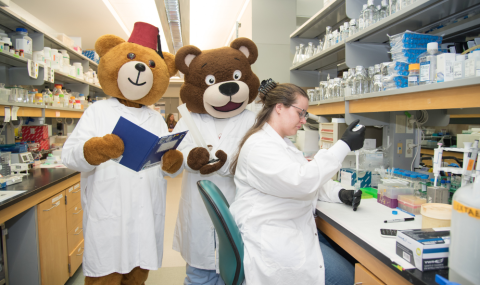The number of people waiting for a liver transplant has always been greater than the number of organs available from deceased donors. Many transplant centres now use living donors to help treat end-stage liver disease. In Canada, our centre performed the first parent-to-child and the first adult-to-adult liver transplants using living donors.
In parent-to-child transplantation, a parent gives a piece of liver (the left lateral segment) to their child. The donor is able to function without all of their liver, which regenerates to its normal previous size within a few months. The piece of liver that is transplanted grows along with the recipient and is able to meet all of the child's requirements.
In adult-to-adult transplantation, a person may be able to donate the right lobe (approximately 60 per cent) of the liver. The amount of liver transplanted must be appropriately size-matched. This is determined by doing CAT scans of the donor and estimating the weight of the right lobe graft, then comparing it to the weight of the recipient. The remaining segment in the donor will regenerate to its normal previous size within a few months. The transplanted liver segment grows in the recipient to the full size of a whole liver.
Who can be a living donor?
The best candidates for living liver donation are family members and close personal friends of the recipient. Anonymous living donors may also be considered.
Living donors should meet these criteria:
- be in excellent physical and psychological health
- be between the ages of 18-55 years old
- have a compatible blood type with the recipient
- come forward to donate voluntarily
- be a healthy weight and about the same physical size (or larger)
- have no history of long-term (chronic) illness such as cancer, diabetes, heart disease
The potential donor will need to undergo several tests to ensure that the liver is working well. This usually takes about 8 weeks for each donor as a series of complex testing is required, including an ultrasound, echocardiogram, stress test, and different types of scans to determine the liver's size and shape as well as the condition of the bile ducts. Donors are thoroughly informed about the risks and are told that they can choose to decline at any time prior to surgery.
Advantages of living-donor liver transplantation
Advantages include:
- helps save the lives of people with end-stage liver disease
- makes more liver transplants available for people on the wait list by giving them a better chance of receiving a deceased donor organ
- surgery can be scheduled before the recipient becomes critically ill, which can improve the transplant's success
- donors experience a sense of deep satisfaction from giving someone "a gift of life"
- financial benefits to the health-care system because the recipient often spends less time in hospital before and after the transplant
Disadvantages of living-donor liver transplantation
There could be some disadvantages to consider, such as:
- extensive donor evaluation might require multiple visits to the hospital
- possible surgical complications, including bleeding, bile duct injury, infection, death
- once discharged from hospital after 6-10 days, out-of-town donors need to stay in London for 2 weeks for follow-up care
- it takes 3-4 months to fully recover and return to everyday, normal activities
To find out more about London's living donor program, read the Liver Donor PDF Handbook.
You can also watch this video, Becoming a Living Liver Donor. Although the video was created by our colleagues in Toronto, London's program has a similar process for donor assessment and surgery.
PRELOD (Program for Reimbursing Expenses of Living Organ Donors)
PRELOD is a program in Ontario to help assist potential and actual living donors with some of the out-of-hospital expenses associated with their donation; for example, travel, parking, accommodation, meals, loss of income. PRELOD aims to reduce the financial burden incurred by living liver donors. There is eligibility criteria that donors must meet to obtain reimbursement.
For further information about PRELOD, you can call 1-888-9PRELOD or 416-619-2342, or email the PRELOD Administrator at PRELOD@giftoflife.on.ca.
Information is also available on the Trillium Gift of Life Network site.
Additional Information
For additional information, please contact our transplant program:
- Email: livingliverdonation@lhsc.on.ca
- Telephone: 519-685-8500 Extension: 33552



